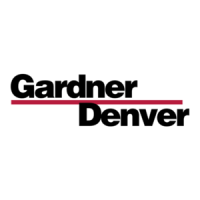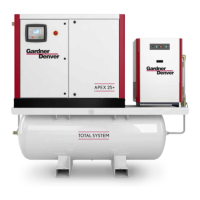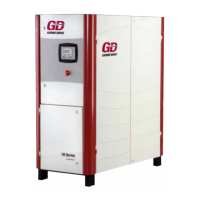Do you have a question about the Gardner Denver AUTO SENTRY EAU99G and is the answer not in the manual?
Services provided by authorized distributors for compressor support and maintenance.
Guidelines for specifying and ordering replacement parts for compressors.
Introduction to the manual and its purpose for operators and maintenance.
Explains hazard levels (Danger, Warning, Caution, Notice) for safe operation.
Description of the rotary screw compressor's design and operation.
Explanation of how air compression is achieved using helical rotors.
Details the path of air and oil through the compressor system after compression.
Describes the oil system's role in lubrication, cooling, and sealing internal clearances.
Explains the function of the turn valve in matching compressor volume to air demand.
Crucial safety notices to prevent severe injury, death, or equipment damage.
Identifies critical danger decals related to high voltage and pressure hazards.
Highlights warning decals concerning rotating machinery and automatic restart risks.
Procedures for unit inspection, damage reporting, and initial checks.
Instructions for safe and proper lifting and moving of the compressor unit.
Criteria for selecting an appropriate and safe installation location for the compressor.
Specific air flow and clearance requirements for air-cooled unit installation.
Air flow requirements for water-cooled unit installation within enclosures.
Guidance on foundation requirements and mounting the compressor unit.
Details on accessing and draining the oil reservoir for maintenance.
Information on enclosure doors, access space, and ventilation for maintenance.
Recommendations for installing units in cold climates to prevent operational issues.
Guidelines for auxiliary air receivers when used to prevent rapid cycling.
Description of the moisture separator/trap and its role in condensate removal.
Information on the factory-wired control piping for the Electra-Saver unit.
Specifications for inlet lines, including cleaning, coating, and sizing.
Details on the discharge service line connection and manifolding units.
Instructions for blowdown valve piping and muffler modification.
Requirements for water piping on units with water-cooled heat exchangers.
Explains series and parallel piping configurations for water-cooled coolers.
Details on factory wiring for standard units and external power connections.
Guidelines for proper equipment grounding according to electrical codes.
Procedures and intervals for lubricating electric motor bearings for optimal operation.
Essential checks and procedures before initial unit operation.
Inspection of air filter and coupling tightness before operation.
Verification of piping, electrical wiring, and grounding integrity.
How to check and confirm correct motor rotation direction for safe operation.
Setting system pressure and selecting the operating mode for the compressor.
Inspection of the unit enclosure for damage, tightness of panels, and latches.
Step-by-step instructions for starting the compressor unit when cold or hot.
Procedures for daily checks and safely stopping the compressor unit.
Overview of prewired controls, motor, starter, and components for the compressor.
How to operate the AutoSentry controller for automatic compressor management.
Explanation of key control devices like the AutoSentry controller and relief valve.
Functionality and location of the oil level gauge and minimum pressure check valve.
How the inlet valve controls air flow and unloads the compressor based on pressure.
Function of solenoid valves and the pressure regulator in controlling air pressure.
Role of the shuttle valve in selecting control air pressure from different sources.
Operation of the purge and blowdown valves for system pressure management.
Description of transducers and switches monitoring system pressure, filters, and temperature.
How to use the emergency stop pushbutton for immediate unit shutdown.
How turn valve and inlet valve regulate compressor capacity and power consumption.
Explanation of the turn valve actuator's role in positioning the valve.
How solenoid valves TVC and TVO control the turn valve position.
Function of the control transformer and terminal strip for unit devices.
Role of fan and main starters in motor control and overload protection.
How the oil system cools the compressor, lubricates parts, and seals clearances.
Information on AEON lubricants, specifications, and their benefits.
Guidelines for operating at high temperatures and effects on lubricant life.
Causes and prevention of moisture accumulation in the oil system.
Instructions for assembling remote elevated cooler packages.
Piping guidelines for aftercoolers and oil heat exchangers, including drain procedures.
Factory modifications to control lines for remote cooler installations.
Reference to cold weather installation procedures for ambient temperature operation.
Procedure for checking and adding oil to the reservoir between scheduled changes.
Steps for upgrading or changing the compressor lubricant type and procedure.
How to read and interpret the oil level gauge for adding or draining oil.
Recommended oil change intervals based on discharge temperature for AEON lubricants.
Methods for draining and cleaning the compressor's oil system.
Step-by-step procedure for filling the oil reservoir with the correct lubricant.
Procedure and interval for replacing the compressor oil filter element.
Information on radiator-type oil coolers, including clearance and cleaning.
Role of the thermostatic mixing valve in controlling oil temperature during warm-up.
Details on water-cooled oil coolers, pressure drops, and water treatment recommendations.
How to adjust the water flow control valve for optimal oil temperature.
Function of the solenoid-operated water shutoff valve in water-cooled systems.
Description of the combined oil reservoir and primary oil separation vessel.
Details on the replaceable cartridge-type oil separator element.
How to monitor oil separator condition via pressure differential and advisories.
Procedure for inspecting the oil separator element for dirt or damage.
Step-by-step guide for removing and replacing the oil separator element.
How to check various oil system parameters for proper operation.
Checking water pressure differential across water-cooled heat exchangers.
Description of the standard heavy-duty washable air filter element.
When and how to service the air filter element based on LED indicators.
Criteria for replacing the air filter element after cleanings or due to damage.
Procedure for inspecting and cleaning the inlet tube for dirt accumulation.
Overview of the flexible coupling and its direct connection function.
Steps for assembling the coupling halves onto the airend and motor shafts.
Instructions for removing and replacing the coupling element.
A list of checks to be performed based on operating conditions and intervals.
Daily checks including oil level, load/unload operation, and pressure.
Checks for dirt accumulation on coolers and cooling fans.
Action required: change the oil filter element.
Action required: change the compressor lubricant.
Annual checks for relief valve and shutdown operations.
Common causes and remedies when the compressor does not start.
Troubleshooting steps for intermittent compressor operation.
Solutions for issues with the compressor's load or unload functionality.
Addressing problems causing the compressor to cycle too frequently between load and unload.
Diagnosing and fixing causes for slow compressor starting.
Troubleshooting low air delivery pressure and overall output issues.
Identifying and resolving causes of high oil consumption and carryover.
Addressing issues leading to high discharge air temperatures.
Diagnosing and fixing causes of oil carryover in the air system.
Services provided by authorized distributors for compressor support and maintenance.
Guidelines for specifying and ordering replacement parts for compressors.
Introduction to the manual and its purpose for operators and maintenance.
Explains hazard levels (Danger, Warning, Caution, Notice) for safe operation.
Description of the rotary screw compressor's design and operation.
Explanation of how air compression is achieved using helical rotors.
Details the path of air and oil through the compressor system after compression.
Describes the oil system's role in lubrication, cooling, and sealing internal clearances.
Explains the function of the turn valve in matching compressor volume to air demand.
Crucial safety notices to prevent severe injury, death, or equipment damage.
Identifies critical danger decals related to high voltage and pressure hazards.
Highlights warning decals concerning rotating machinery and automatic restart risks.
Procedures for unit inspection, damage reporting, and initial checks.
Instructions for safe and proper lifting and moving of the compressor unit.
Criteria for selecting an appropriate and safe installation location for the compressor.
Specific air flow and clearance requirements for air-cooled unit installation.
Air flow requirements for water-cooled unit installation within enclosures.
Guidance on foundation requirements and mounting the compressor unit.
Details on accessing and draining the oil reservoir for maintenance.
Information on enclosure doors, access space, and ventilation for maintenance.
Recommendations for installing units in cold climates to prevent operational issues.
Guidelines for auxiliary air receivers when used to prevent rapid cycling.
Description of the moisture separator/trap and its role in condensate removal.
Information on the factory-wired control piping for the Electra-Saver unit.
Specifications for inlet lines, including cleaning, coating, and sizing.
Details on the discharge service line connection and manifolding units.
Instructions for blowdown valve piping and muffler modification.
Requirements for water piping on units with water-cooled heat exchangers.
Explains series and parallel piping configurations for water-cooled coolers.
Details on factory wiring for standard units and external power connections.
Guidelines for proper equipment grounding according to electrical codes.
Procedures and intervals for lubricating electric motor bearings for optimal operation.
Essential checks and procedures before initial unit operation.
Inspection of air filter and coupling tightness before operation.
Verification of piping, electrical wiring, and grounding integrity.
How to check and confirm correct motor rotation direction for safe operation.
Setting system pressure and selecting the operating mode for the compressor.
Inspection of the unit enclosure for damage, tightness of panels, and latches.
Step-by-step instructions for starting the compressor unit when cold or hot.
Procedures for daily checks and safely stopping the compressor unit.
Overview of prewired controls, motor, starter, and components for the compressor.
How to operate the AutoSentry controller for automatic compressor management.
Explanation of key control devices like the AutoSentry controller and relief valve.
Functionality and location of the oil level gauge and minimum pressure check valve.
How the inlet valve controls air flow and unloads the compressor based on pressure.
Function of solenoid valves and the pressure regulator in controlling air pressure.
Role of the shuttle valve in selecting control air pressure from different sources.
Operation of the purge and blowdown valves for system pressure management.
Description of transducers and switches monitoring system pressure, filters, and temperature.
How to use the emergency stop pushbutton for immediate unit shutdown.
How turn valve and inlet valve regulate compressor capacity and power consumption.
Explanation of the turn valve actuator's role in positioning the valve.
How solenoid valves TVC and TVO control the turn valve position.
Function of the control transformer and terminal strip for unit devices.
Role of fan and main starters in motor control and overload protection.
How the oil system cools the compressor, lubricates parts, and seals clearances.
Information on AEON lubricants, specifications, and their benefits.
Guidelines for operating at high temperatures and effects on lubricant life.
Causes and prevention of moisture accumulation in the oil system.
Instructions for assembling remote elevated cooler packages.
Piping guidelines for aftercoolers and oil heat exchangers, including drain procedures.
Factory modifications to control lines for remote cooler installations.
Reference to cold weather installation procedures for ambient temperature operation.
Procedure for checking and adding oil to the reservoir between scheduled changes.
Steps for upgrading or changing the compressor lubricant type and procedure.
How to read and interpret the oil level gauge for adding or draining oil.
Recommended oil change intervals based on discharge temperature for AEON lubricants.
Methods for draining and cleaning the compressor's oil system.
Step-by-step procedure for filling the oil reservoir with the correct lubricant.
Procedure and interval for replacing the compressor oil filter element.
Information on radiator-type oil coolers, including clearance and cleaning.
Role of the thermostatic mixing valve in controlling oil temperature during warm-up.
Details on water-cooled oil coolers, pressure drops, and water treatment recommendations.
How to adjust the water flow control valve for optimal oil temperature.
Function of the solenoid-operated water shutoff valve in water-cooled systems.
Description of the combined oil reservoir and primary oil separation vessel.
Details on the replaceable cartridge-type oil separator element.
How to monitor oil separator condition via pressure differential and advisories.
Procedure for inspecting the oil separator element for dirt or damage.
Step-by-step guide for removing and replacing the oil separator element.
How to check various oil system parameters for proper operation.
Checking water pressure differential across water-cooled heat exchangers.
Description of the standard heavy-duty washable air filter element.
When and how to service the air filter element based on LED indicators.
Criteria for replacing the air filter element after cleanings or due to damage.
Procedure for inspecting and cleaning the inlet tube for dirt accumulation.
Overview of the flexible coupling and its direct connection function.
Steps for assembling the coupling halves onto the airend and motor shafts.
Instructions for removing and replacing the coupling element.
A list of checks to be performed based on operating conditions and intervals.
Daily checks including oil level, load/unload operation, and pressure.
Checks for dirt accumulation on coolers and cooling fans.
Action required: change the oil filter element.
Action required: change the compressor lubricant.
Annual checks for relief valve and shutdown operations.
Common causes and remedies when the compressor does not start.
Troubleshooting steps for intermittent compressor operation.
Solutions for issues with the compressor's load or unload functionality.
Addressing problems causing the compressor to cycle too frequently between load and unload.
Diagnosing and fixing causes for slow compressor starting.
Troubleshooting low air delivery pressure and overall output issues.
Identifying and resolving causes of high oil consumption and carryover.
Addressing issues leading to high discharge air temperatures.
Diagnosing and fixing causes of oil carryover in the air system.
| Manufacturer | Gardner Denver |
|---|---|
| Power Source | Electric |
| Maximum Pressure | 175 PSI |
| Phase | 3 |
| Model | EAU99G |











